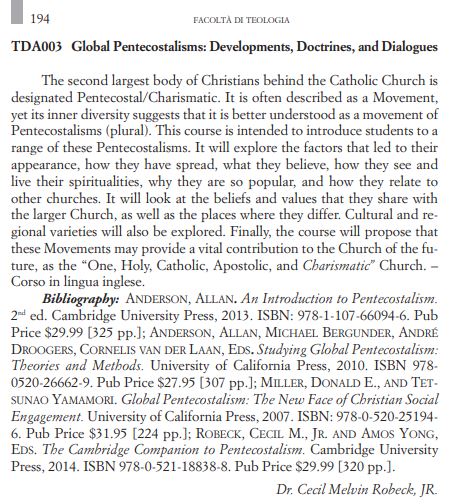Reflections on a Term at the Gregorian University
There were no classes the week after Easter, so the day after we met with Pope Francis, Patsy and I rode with a Fr. William Henn, OFM Capp. to Venice. After so many weeks of gray skies and rain, it was a refreshing break to drive north for 5 hours on a day filled with sunshine, green fields, blossoming orchards, and large stands of mustard. Bill and I have worked for years either in the Catholic – Pentecostal Dialogue or on the World Council of Churches’ Commission on Faith and Order. The occasion was a meeting between the staff of the Institute for Ecumenical Research run by the Lutheran World Federation in Strasbourg, France, and the Instituto di Studi Ecumenici “San Bernardino” located in Venice and run by Franciscans. We were given a very nice room in a building that overlooked a two-acre garden and the lagoon.
How do Lutherans understand Luther’s 95 theses today?

Snapshot from the course catalog.
My students have now submitted their papers. They cover a wide range of topics that range from healing to prosperity, from West Africa to Vietnam, the relationship between Pentecostalism and globalism, and the role of women in Pentecostalism in which the writer hopes ultimately to bring about change in the Catholic Church. Given the limitations they faced without adequate textbook support, their work is admirable. I will pray for their success as they seek to follow God’s call upon their lives.
After meeting with various members of the Jesuit community over meals, I was invited one last time to sit with a good-sized group of them, including the Dean of the university for a two-hour time of conversation. Questions came from many of them. Some wanted more information about various aspects of Pentecostal and Charismatic history and theology. Others wanted to know how I view the Catholic Church. The conversation was free ranging, but genuine, respectful, and hopeful throughout. In the end, several of them remarked that they hoped I would return. All of us were very pleased with the exchange. They dismissed for dinner, and I returned to the Lay Centre, where Patsy and I were treated as first-time guests at a special dinner arranged by the staff and students alike. It was a delightful evening, with speeches, and prayers, and singing, and laughing throughout.
“When I was young, I committed myself to follow Jesus. When He called me to work ecumenically, I argued with Him, but ultimately decided that I must follow Him.” –Mel Robeck
When I was young, I committed myself to follow Jesus. When He called me to work ecumenically, I argued with Him, but ultimately decided that I must follow Him. During my theological training, it never crossed my mind that I would be given the opportunities and privileges that I have had. I can only testify to being the recipient of grace upon grace. My prayer is that my Pentecostal and Charismatic sisters and brothers will look again at what God is doing in His Church, and set aside those things which keep us from trusting Him completely. The results can bring fruit that we could not have imagined. All they require is faithfulness to His call.
PR
Further Reading:
On June 12, 2018, the Lay Centre published an interview with Mel Robeck entitled, “Professor follows Jesus’ call in commitment to ecumenism” about his stay at the Centre.
Notes
[1] Russell P. Spittler, “Implicit Values in Pentecostal Missions,” Missiology 16 (1988), 409-424.
[2] “Pentecostal Ecumenism: Overcoming the Challenges – Reaping the Benefits,” (Part I), The Journal of the European Pentecostal Theological Association 34:2 (2014), 113-132; (Part II), The Journal of the European Pentecostal Theological Association 35:1 (2015), 5-17.
[3] W. F. Carothers, The Baptism with the Holy Ghost and Speaking in Tongues (Houston, TX: W. F. Carothers, 1906-7), 25.
[4] This claim appears in “The Apostolic Faith Movement,” The Apostolic Faith [Los Angeles, CA] 1.1 September 1906), 2.1. This statement also appears in “Declare Parham Is Gaining,” The Waukegan Daily Gazette (September 28, 1906), 6, as coming from a “circular” distributed by Charles F. Parham, Projector.
[5] B.H. Streeter, The Primitive Church: Studied with Special Reference to the Origins of the Christian Ministry (London, England: Macmillan and Co., 1929), 69.
[6] At the request of the university, I submitted the paper too the university’s quarterly journal, Gregorianum. It is slated for publication.
Category: Ministry, Spring 2018


